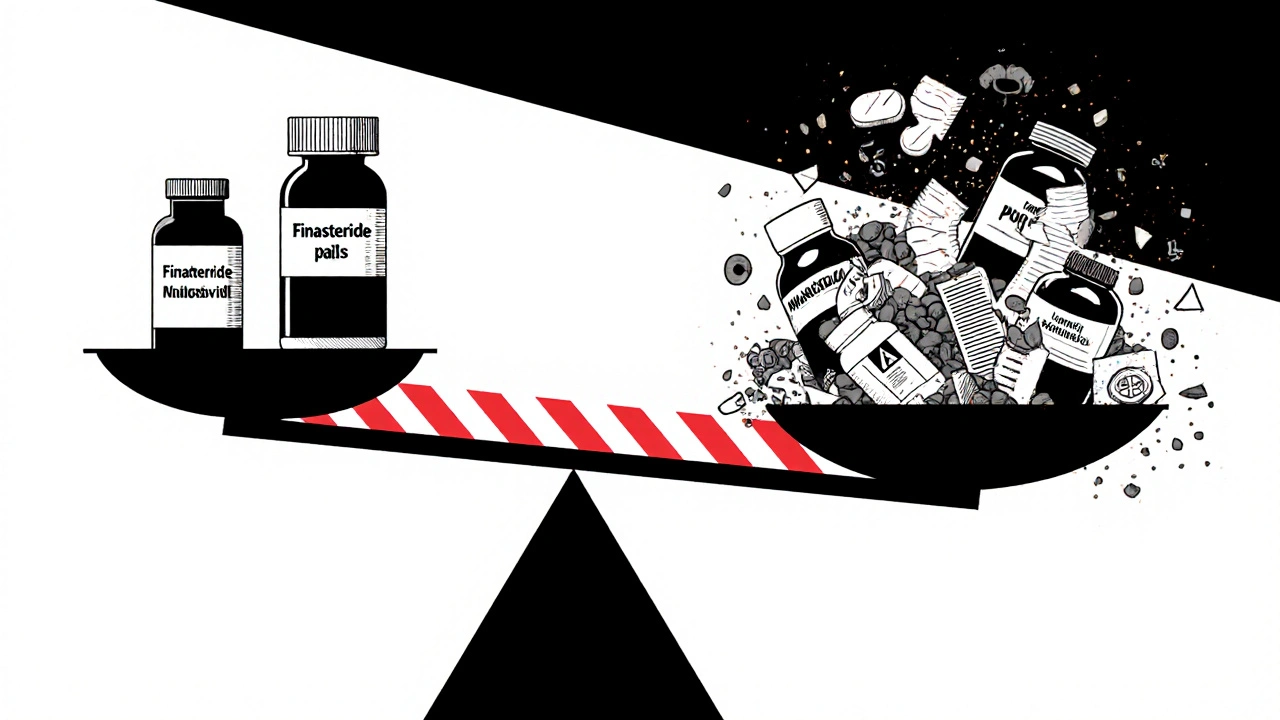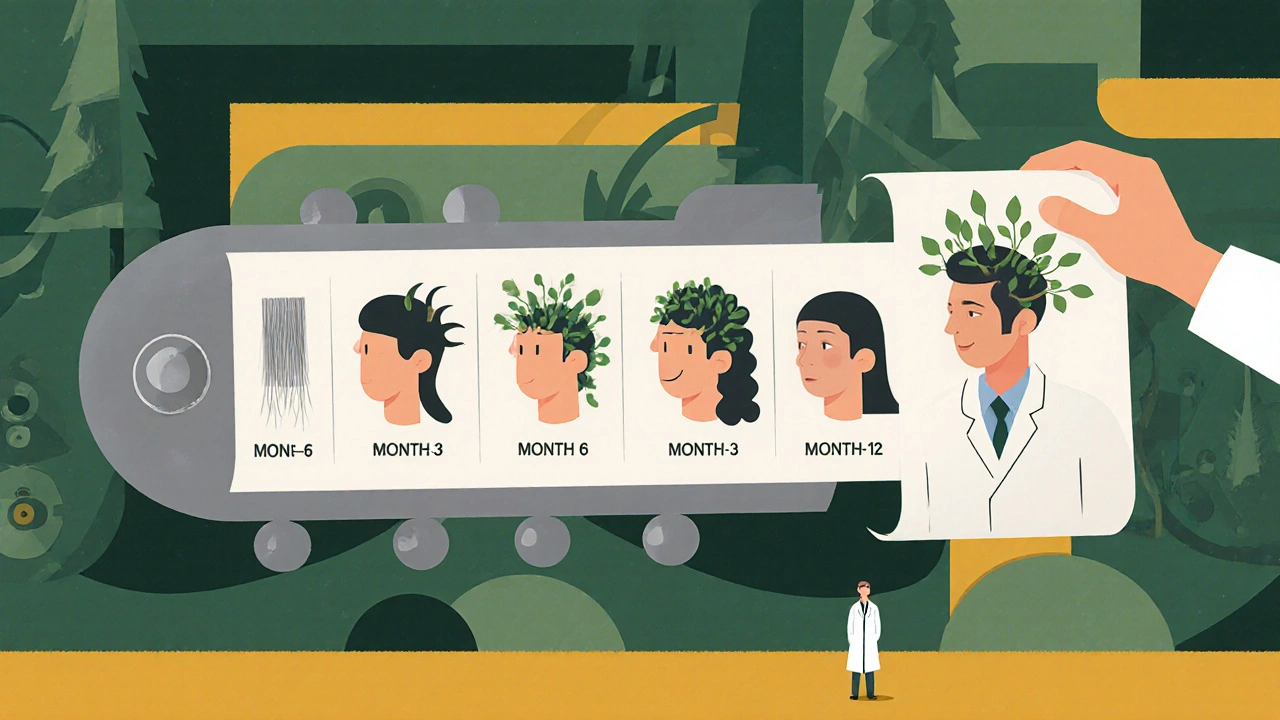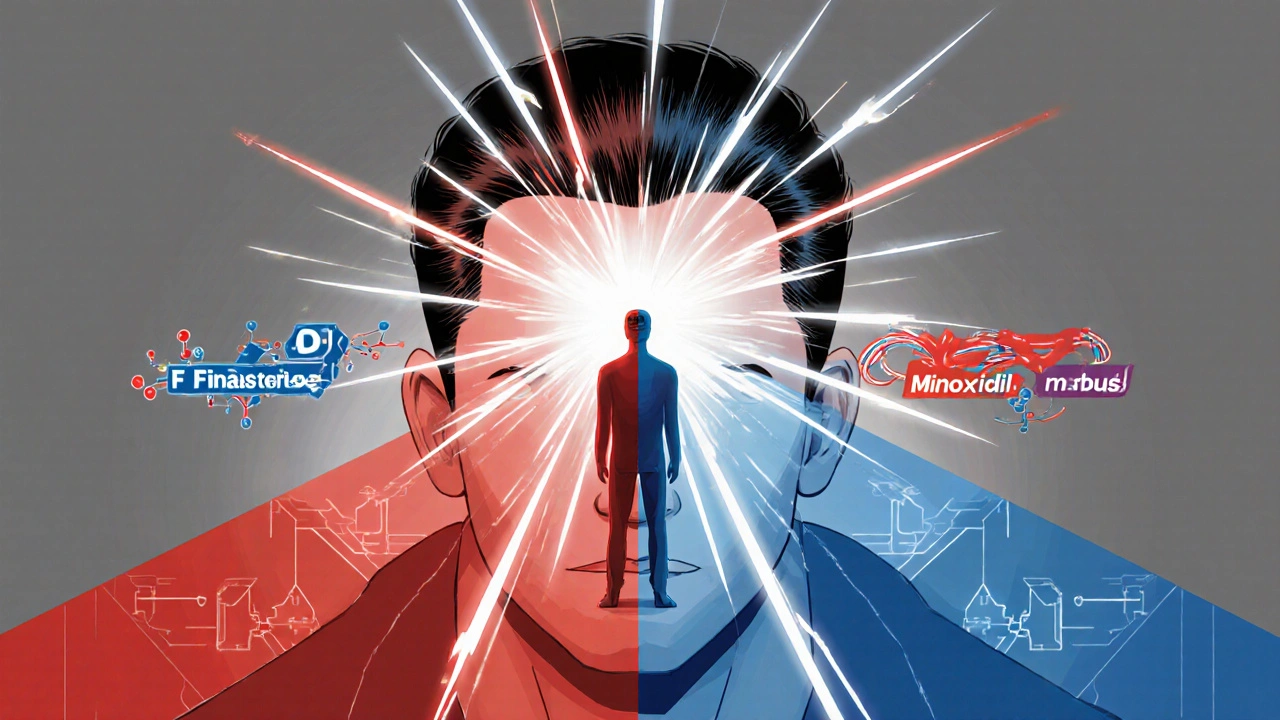Finasteride is one of the most proven treatments for male pattern baldness, but many people don’t stop at just one medication. They want to stack it with other options-minoxidil, low-level laser therapy, or even supplements-to get the best possible results. The question isn’t whether you can combine treatments-it’s whether you’re doing it safely and effectively. Too many people jump into combinations without understanding how they interact, risk side effects, or waste money on products that don’t add value. This guide breaks down exactly what works, what doesn’t, and how to layer treatments without harming your health or your wallet.
How Finasteride Actually Works
Finasteride blocks the enzyme 5-alpha-reductase, which turns testosterone into dihydrotestosterone (DHT). DHT shrinks hair follicles over time, leading to thinning and eventual hair loss. By lowering DHT levels by up to 70%, finasteride stops this process in its tracks. It doesn’t regrow hair on its own, but it prevents further loss-and in about 65% of men, it leads to some regrowth after 6-12 months of consistent use.
It’s not a miracle drug. You need to take it every day, and if you stop, your hair will likely fall out again within 6-12 months. That’s why people look for ways to boost its effects. But adding more treatments isn’t always better. Some help. Some do nothing. A few can even cause problems.
What Works Best with Finasteride
The only treatment with strong clinical backing to combine with finasteride is minoxidil. The two work in completely different ways, and together, they’re more effective than either alone.
Minoxidil is a topical solution or foam that opens potassium channels in hair follicles, increasing blood flow and nutrient delivery. It doesn’t touch DHT-it just wakes up dormant follicles. A 2019 study published in the Journal of the American Academy of Dermatology found that men using both finasteride and 5% minoxidil had significantly better hair density after one year than those using only one of the two.
Use them together: take finasteride orally once a day, and apply minoxidil twice daily to the scalp. There’s no known interaction between them. They don’t compete, cancel out, or increase side effects. Many dermatologists consider this the gold standard for hair loss treatment.
Low-Level Laser Therapy (LLLT): Does It Help?
LLLT devices-helmets, combs, or caps that emit red light-are popular. They’re non-invasive, FDA-cleared, and marketed as a “natural” alternative. But do they add real value when used with finasteride?
Studies show modest benefits. A 2022 meta-analysis in Lasers in Surgery and Medicine found that LLLT improved hair count by about 20% over placebo when used alone. When combined with finasteride, the improvement was slightly higher-but still not dramatically so. Most users see subtle thickening, not dramatic regrowth.
If you’re already using finasteride and minoxidil, LLLT might give you a small extra boost. But it’s expensive. A good device costs $300-$600, and you need to use it 3-4 times a week for at least 6 months to see results. For most people, the money is better spent on a higher concentration of minoxidil or a prescription like dutasteride (if approved by a doctor).
What About Supplements and Natural Products?
There’s a whole industry built around hair growth supplements: biotin, saw palmetto, pumpkin seed oil, zinc, collagen, and more. Many of them claim to block DHT or stimulate follicles. But the science is weak.
Saw palmetto is often marketed as a “natural finasteride.” It does have mild 5-alpha-reductase inhibiting properties, but it’s nowhere near as potent. One study showed it reduced DHT by only 32%-compared to finasteride’s 70%. And there’s no solid evidence it works better than placebo when taken with finasteride.
Biotin? It helps only if you’re deficient-which is rare. Most people get enough from eggs, nuts, and leafy greens. Taking 5,000 mcg a day won’t make your hair grow faster. It just makes your nails stronger and your urine bright yellow.
Pumpkin seed oil? One small 2014 trial showed a 40% increase in hair count after 24 weeks, but it was only 76 men, and the study wasn’t double-blind. It’s not a replacement for finasteride. At best, it might offer a tiny edge if you’re already on a solid regimen.
Bottom line: Skip the expensive supplements unless you have a diagnosed deficiency. Stick with what’s proven.

What to Avoid
Some treatments are dangerous when combined with finasteride-or just plain useless.
Don’t mix finasteride with dutasteride unless under strict medical supervision. Both are 5-alpha-reductase inhibitors. Taking them together increases side effect risk-like sexual dysfunction, depression, or brain fog-without significantly improving results. Doctors rarely prescribe both, and only for severe cases that don’t respond to one.
Avoid topical DHT blockers like ketoconazole shampoo unless you’re using it for its anti-inflammatory properties. While it may help with scalp health, it doesn’t block DHT systemically like finasteride. It’s fine to use alongside finasteride, but don’t expect miracles.
And skip hair transplants unless you’ve given finasteride a real try. Many people rush into surgery without realizing that finasteride can delay or even eliminate the need for it. If you’re still losing hair after 12 months on finasteride, then transplants become a reasonable next step.
Realistic Expectations and Timeline
Combining treatments doesn’t mean faster results. Hair grows slowly. Even with finasteride and minoxidil, you won’t see changes in the first 3 months. Most people notice shedding in weeks 2-8-that’s normal. It’s the old hairs making room for new ones.
By month 6, you might see less shedding and slight thickening. At 12 months, that’s when you’ll start seeing real results: more coverage, denser strands, fewer visible parts. If you’re still losing hair after a year, talk to a dermatologist. You might need a higher dose of minoxidil, or a different approach entirely.
Don’t chase overnight fixes. Hair growth is a marathon, not a sprint. And consistency beats intensity every time.
Monitoring Side Effects
Finasteride’s main side effects are sexual: lower libido, erectile dysfunction, or reduced semen volume. They happen in about 2-4% of users, and most go away after stopping the drug. But if you’re adding other treatments, you need to track everything.
Keep a journal: note your mood, libido, energy levels, and any scalp irritation from minoxidil. If you notice a change after adding a new product, pause it. See if symptoms improve. Then reintroduce it one at a time to find the culprit.
Also, watch for scalp dryness or flaking from minoxidil. It’s common. Use a gentle, sulfate-free shampoo. Moisturize with a light, non-comedogenic oil like jojoba. If irritation persists, switch to the foam version-it’s less irritating than the liquid.

When to See a Doctor
You don’t need a prescription for finasteride in Canada if you’re buying it from a licensed online pharmacy with a valid prescription. But you should still talk to a doctor before combining treatments.
See a dermatologist if:
- You’re under 18 or over 65
- You have liver disease or depression
- Finasteride isn’t working after 12 months
- You’re experiencing persistent side effects
- You’re considering dutasteride, spironolactone, or other off-label options
A doctor can check your hormone levels, rule out other causes of hair loss (like thyroid issues or iron deficiency), and help you design a safe, personalized plan.
Final Checklist: Safe Combination Protocol
Here’s what a safe, effective routine looks like:
- Take 1 mg finasteride daily, at the same time each day.
- Apply 5% minoxidil twice daily to the scalp. Let it dry completely.
- Use a gentle shampoo daily. Avoid harsh sulfates.
- Hold off on supplements unless you have a diagnosed deficiency.
- Track progress with monthly photos-same lighting, same angle.
- Give it 12 months before judging results.
- Stop everything and see a doctor if you notice mood changes, sexual side effects, or sudden hair loss.
This isn’t about doing more. It’s about doing the right things, consistently, and without unnecessary risk. Finasteride is powerful. Minoxidil complements it. Everything else? It’s noise.
Can I use finasteride and minoxidil together safely?
Yes, finasteride and minoxidil are safe to use together. They work through different mechanisms-finasteride lowers DHT, while minoxidil stimulates blood flow to follicles. Studies show the combination is more effective than either alone. No dangerous interactions exist between them.
How long does it take to see results with finasteride and minoxidil?
Most people notice reduced shedding after 2-3 months. Visible thickening usually appears around 6 months. Full results take 12-18 months. Patience is key-hair growth is slow, and consistency matters more than intensity.
Does saw palmetto work as well as finasteride?
No. Saw palmetto may reduce DHT slightly, but studies show it’s only about half as effective as finasteride. It’s not a substitute. If you’re taking finasteride, saw palmetto adds little to no benefit and isn’t worth the cost.
Can I take biotin with finasteride?
Yes, biotin is safe to take with finasteride. But unless you have a diagnosed biotin deficiency-which is rare-it won’t improve hair growth. Most people get enough biotin from food. Spending money on high-dose biotin supplements is unnecessary.
Should I combine finasteride with dutasteride?
Only under a doctor’s supervision. Both drugs block DHT, and combining them increases side effect risks-like sexual dysfunction or depression-without guaranteeing better results. Most doctors avoid this combination unless finasteride alone fails completely.
What if finasteride doesn’t work for me?
If you’ve used finasteride for 12 months with no improvement, talk to a dermatologist. You might have a different type of hair loss, like telogen effluvium or an autoimmune condition. Blood tests for iron, thyroid, and vitamin D can help. In some cases, spironolactone or low-dose oral minoxidil may be options.
Next Steps
If you’re just starting out, begin with finasteride and 5% minoxidil. Stick with them for a full year. Take monthly photos. Track shedding. Don’t add anything else until you’ve given the core duo a real chance.
If you’re already on multiple treatments and not seeing results, simplify. Remove the unproven supplements, laser devices, or shampoos. Focus on the two proven options. Sometimes, less is more.
Hair loss isn’t a race. It’s a long-term game. The people who win aren’t the ones who try everything-they’re the ones who stick with what works, and do it consistently.

Emily Kidd
October 30, 2025 AT 02:35just started finasteride + minoxidil 3 months ago and honestly? the shedding scared me at first but now my part looks way less obvious. no magic, just consistency. also, the foam version is a game changer for my itchy scalp.
Prakash pawar
October 30, 2025 AT 13:34look i get it you wanna be scientific but lets be real most of these supplements are just fancy placebos sold by guys who wear hemp shirts and sell moonstone crystals. saw palmetto? nah bro. if you want results stop wasting cash on herbal tea and just take the pill that science actually tested.
caiden gilbert
October 30, 2025 AT 15:06the real villain here isnt the supplement industry its the algorithm that keeps feeding us 17 different ‘miracle hair serums’ every time we google ‘thinning hair’. i tried 5 of them. my wallet cried. my hair stayed the same. then i went full minimalist: finasteride, minoxidil, and a $12 sulfate-free shampoo. 8 months in and my crown finally feels less like a desert.
Alex Hundert
October 30, 2025 AT 19:58if you're still debating whether to add laser caps or biotin after reading this guide you're not looking for advice-you're looking for excuses to keep spending money. the science is clear. two treatments. one year. no distractions. if you can't stick to that you're not ready for results.
Justin Cheah
November 1, 2025 AT 13:02you know what they dont tell you about finasteride? the FDA knew about the brain fog and depression risks back in 2011 but let it slide because pharma made too much cash. now they slap a warning label on it like its your fault for feeling weird. and dont get me started on how they market minoxidil as ‘natural’ when its a vasodilator originally developed for hypertension. we're being played. stick to the basics if you must but don't pretend this is clean science.
Carolyn Kiger
November 1, 2025 AT 15:25i was skeptical at first but after 14 months on finasteride and minoxidil i finally see my grandma’s thick hair again-not perfect but way better than the receding widow’s peak i had at 28. i stopped buying every new serum that popped up on tiktok. i just kept doing the boring stuff. if you’re reading this and you’re in your 20s? start now. your future self will thank you.
phenter mine
November 2, 2025 AT 07:38hey i just wanted to say thanks for this post. i was about to buy a $500 laser comb but i read the part about saw palmetto and realized i was wasting my time. switched to foam minoxidil and i already feel better. also i spelled ‘minoxidil’ wrong 3 times in this comment oops lol
MOLLY SURNO
November 3, 2025 AT 14:26Thank you for the clear, evidence-based breakdown. It’s refreshing to see a guide that doesn’t oversimplify or overpromise. Consistency, patience, and avoiding unnecessary interventions are the true pillars of effective hair loss management. I’ve shared this with several friends who were overwhelmed by conflicting advice online.